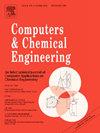A multi-parametric programming approach for combined flexibility, availability, and resilience in process design
IF 3.9
2区 工程技术
Q2 COMPUTER SCIENCE, INTERDISCIPLINARY APPLICATIONS
引用次数: 0
Abstract
Process systems are perpetually vulnerable to disruptions from within and outside the system, as well as to uncertainties in operating parameters, all of which may adversely affect system performance. Incorporating resilience in the conceptual process design stage allows for the integration of various correlated design goals such as flexibility, availability, and ability to quickly recover during disruptions. In this work, a methodology based on the flexibility analysis is presented that provides a path to quantifying the ability of a proposed design to manage uncertainties and disruptions through a Combined Flexibility-Availability-Resilience Index (CFARI). This metric represents the likelihood that a design is feasible given the desired flexibility, availability, and resilience goals. The proposed method systematically explores the feasible space as described by the process constraints, uncertainties, and relevant disruptions through multi-parametric programming to determine this likelihood. Given a range of possible values for design variables, the CFARI can be correlated with design variables and then applied to a design optimization formulation to represent the resilience objective. Through this method, resilience is considered holistically through integration with flexibility and availability, and trade-offs with other objectives in the design stage can be explored. Case studies involving different process systems are presented to illustrate the applicability of the CFARI as a resilience metric.
过程设计中结合灵活性、可用性和弹性的多参数规划方法
过程系统总是容易受到来自系统内部和外部的破坏,以及操作参数的不确定性,所有这些都可能对系统性能产生不利影响。在概念流程设计阶段结合弹性可以集成各种相关的设计目标,例如灵活性、可用性和在中断期间快速恢复的能力。在这项工作中,提出了一种基于灵活性分析的方法,该方法通过组合灵活性-可用性-弹性指数(CFARI),提供了一种量化拟议设计管理不确定性和中断的能力的途径。这个度量表示给定期望的灵活性、可用性和弹性目标的设计是可行的可能性。提出的方法通过多参数规划系统地探索由过程约束、不确定性和相关中断所描述的可行空间,以确定这种可能性。给定设计变量的可能值范围,CFARI可以与设计变量相关联,然后应用于设计优化公式来表示弹性目标。通过这种方法,弹性通过与灵活性和可用性的集成被整体地考虑,并且可以在设计阶段与其他目标进行权衡。介绍了涉及不同过程系统的案例研究,以说明CFARI作为弹性度量的适用性。
本文章由计算机程序翻译,如有差异,请以英文原文为准。
求助全文
约1分钟内获得全文
求助全文
来源期刊

Computers & Chemical Engineering
工程技术-工程:化工
CiteScore
8.70
自引率
14.00%
发文量
374
审稿时长
70 days
期刊介绍:
Computers & Chemical Engineering is primarily a journal of record for new developments in the application of computing and systems technology to chemical engineering problems.
 求助内容:
求助内容: 应助结果提醒方式:
应助结果提醒方式:


